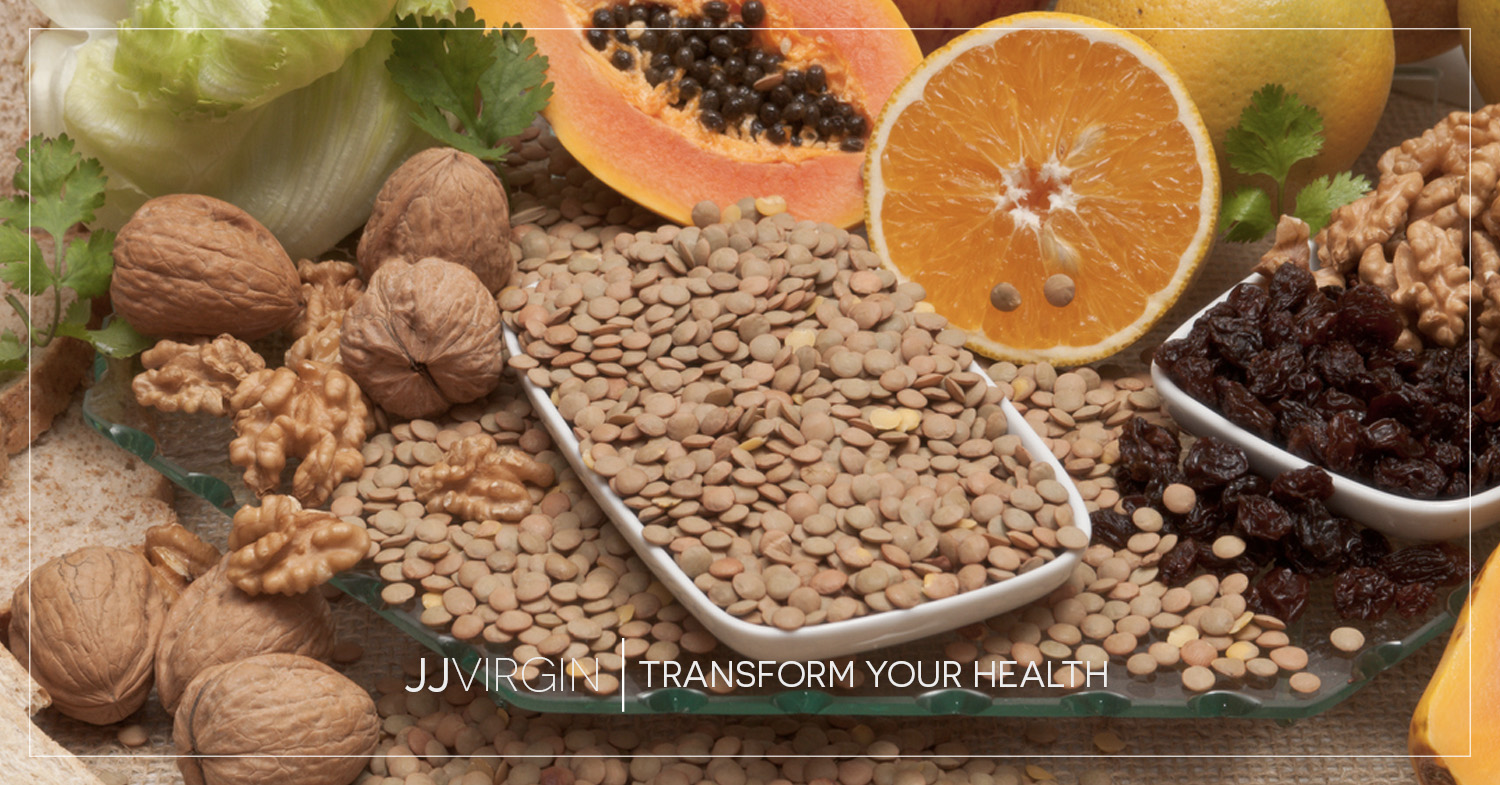When it comes to blood sugar balance and eating for weight management, eating by the plate is key to reaching your goals. An important component of this method is making sure you have enough fiber in your meals. It’s one-third of what I call the Satiety Trifecta—a balance of protein, fat, and fiber on your plate.
Where are the carbs? Fiber is a type of carbohydrate! And it’s one I want you to prioritize.
Why Is Fiber Important?
Fiber comes from plants and is essential for the health of your digestive system. It adds bulk to your stool and keeps things moving smoothly and regularly, so you don’t experience diarrhea, constipation, and the cascade of health issues chronic digestive problems can bring on. Fiber also lowers the risk of colorectal cancer, according to the Mayo Clinic.
And its benefits don’t stop in the bathroom. Getting adequate dietary fiber is also important for:
- Helping you feel full, so you’re not eating dinner and wondering why you’re still hungry an hour later1
- Supporting your weight-loss efforts by keeping you satisfied without cravings and providing more nutrient density2
- Balancing your blood-sugar levels by slowing the absorption of sugar into the bloodstream and avoiding glucose or blood sugar spikes3
- Maintaining healthy cholesterol levels by lowering low-density lipoprotein, or LDL (the kind that we want to be low in relation to the “good” cholesterol, HDL)4
- Feeding the good bacteria in your gut and boosting your immune system, because over 70% of your immune system lives in the gut5
- Helping reduce your risk of heart disease, the number one cause of death among women in the US, and type 2 diabetes6-8
The key is to be sure you’re eating plenty of it to reap all those rewards.
How Much Fiber Do I Need Every Day?
The Institute of Medicine recommends about 20-40 grams of fiber per day, depending on your age and gender.
You know what’s really frightening? Most Americans are only getting a mere fraction of that amount!
Scientific reports show that the average fiber intake for women is only 12-13 grams per day, and men aren’t faring much better with a measly 16-17 grams.9 That tells me we’ve got a lot of work to do.
After working with thousands of clients throughout the years, I’ve found that 50 grams of fiber is a more optimal amount for preventing illness and protecting your health.
How to Increase Your Fiber Intake Safely
Before you go loading up on beans and Brussels sprouts, keep in mind that fiber intake should be increased gradually to avoid intestinal distress. (We’ve all been there before and it’s not pleasant!)
The best way to do that is by raising the amount of fiber you eat every few days by 5-gram increments. If you experience digestive symptoms, you may want to increase in smaller increments and wait until the issues stop before you decide to bump it up again.
Rinse and repeat until you’re eating the goal of around 50 grams per day.
Meeting your fiber quota from food alone can be a challenge! That’s why we created Extra Fiber. Each serving packs 12 types of fiber, including a prebiotic that supports the growth of friendly bacteria.* This is the Rolls Royce of fiber products… and you can only get it here.
The Best Foods to Increase Your Fiber Intake
To help make it even easier to add fiber-rich foods to your menu, I’ve rounded up 10 of my favorite high-fiber foods, with plenty of delicious recipes from my library and from trusted friends to add to your meal plan.
1. Beans, chickpeas, and lentils (13.2 to 16.3 grams per cup)
- Vegetarian White Chili
- Chickpea Falafel Salad with Tahini Dressing
- Lentil Nut Burgers with Cilantro Vinaigrette
2. Artichokes (10.3 grams per cup)
- Roasted Artichoke Dip
- Lemony Roasted Artichoke Hearts
- Massaged Kale Salad with Sardines & Artichoke Hearts
3. Berries (7.6 to 8 grams per cup for blackberries and raspberries)
4. Avocados (6.7 grams per cup)
5. Broccoli (5.1 grams per cup)
- Paleo Steamed Broccoli with Garlic Oil Drizzle
- Easy Detox Vegetable Fritters
- Cruciferous Veggie Bake
6. Chia Seeds (5.5 grams per tablespoon)
- Blueberry Pecan Vanilla Chia Seed Pudding
- Dr. Mark Hyman’s Flourless Protein Power Bread
- Almond-Cacao Smoothie Balls
7. Cooked Quinoa (5.2 grams per cup)
- Roasted Vegetable and Quinoa Chicken Salad
- Hot Quinoa Cereal with Warm Berry Compote
- Quinoa Tabouli Salad
8. Brussels Sprouts (4.1 grams per cup)
- Roasted Brussels Sprouts with Bacon
- Shaved Brussels Sprouts Salad with Lemon-Thyme Vinaigrette
- Bacon And Balsamic Brussels Sprouts with Almonds
9. Rolled Oats (4 grams per cup)
- Butternut Pecan Overnight Oats
- Blueberry-Vanilla Oatmeal Protein Muffins
- Triple-Chocolate Berry Overnight Oats
10. Apples (2.6 grams per cup)
As well as my top high-fiber foods to include in your diet, you’ll also want to incorporate forms of resistant starch as well. Resistant starch is similar to fiber in that it resists digestion (hence the name). It has similar benefits like blood-sugar management, reduced appetite, microbial balance, and more.
Resistant starch is a prebiotic, which essentially feeds probiotics in the large intestine and helps them thrive in the gut.
You’ll find this nutrient in foods like green bananas (which I recommend freezing for loaded smoothies), potatoes, legumes, and other starchy foods.
With a variety of vegetables, fruit, legumes, nuts, seeds, and other plant foods, you’ll be well on your way to your optimal intake of fiber and the amazing energy and health benefits that come with it.
The views in this blog by JJ Virgin should never be used as a substitute for professional medical advice. Please work with a healthcare practitioner concerning any medical problem or concern. The information here is not intended to diagnose, treat, or prevent any disease or condition. Statements contained here have not been evaluated by the Food and Drug Administration.
*These statements have not been evaluated by the Food and Drug Administration. This product is not intended to diagnose, treat, cure, or prevent any disease.
References:
- Howarth NC, Saltzman E, Roberts SB. Dietary fiber and weight regulation. Nutr Rev. 2001 May;59(5):129-39. doi: 10.1111/j.1753-4887.2001.tb07001.x. PMID: 11396693.
- Clark MJ, Slavin JL. The effect of fiber on satiety and food intake: a systematic review. J Am Coll Nutr. 2013;32(3):200-11. doi: 10.1080/07315724.2013.791194. PMID: 23885994.
- Bolton RP, Heaton KW, Burroughs LF. The role of dietary fiber in satiety, glucose, and insulin: studies with fruit and fruit juice. Am J Clin Nutr. 1981 Feb;34(2):211-7. doi: 10.1093/ajcn/34.2.211. PMID: 6259919.
- http://olivamine.com/sites/default/files/pdf/Prebiotic-Fiber/Fiber-Cholesterol-Lowering.pdf
- Slavin J. Fiber and prebiotics: mechanisms and health benefits. Nutrients. 2013 Apr 22;5(4):1417-35. doi: 10.3390/nu5041417. PMID: 23609775; PMCID: PMC3705355.
- Pirjo Pietinen, Eric B. Rimm, Pasi Korhonen, Anne M. Hartman, Walter C. Willett, Demetrius Albanes and Jarmo Virtamo. Intake of Dietary Fiber and Risk of Coronary Heart Disease in a Cohort of Finnish Men. Circulation. 1996;94:2720–2727. https://doi.org/10.1161/01.CIR.94.11.2720
- http://www.fiberwater.com/_pdf/4Fiberdecreasedriskofcoronaryheartdiseaseinwomen.pdf
- R Giacco, M Parillo, A A Rivellese, G Lasorella, A Giacco, L D’Episcopo, G Riccardi; Long-term dietary treatment with increased amounts of fiber-rich low-glycemic index natural foods improves blood glucose control and reduces the number of hypoglycemic events in type 1 diabetic patients.. Diabetes Care 1 October 2000; 23 (10): 1461–1466. https://doi.org/10.2337/diacare.23.10.1461
- Roger Clemens, Sibylle Kranz, Amy R. Mobley, Theresa A. Nicklas, Mary Pat Raimondi, Judith C. Rodriguez, Joanne L. Slavin, Hope Warshaw, Filling America’s Fiber Intake Gap: Summary of a Roundtable to Probe Realistic Solutions with a Focus on Grain-Based Foods, The Journal of Nutrition, Volume 142, Issue 7, July 2012, Pages 1390S–1401S, https://doi.org/10.3945/jn.112.160176






